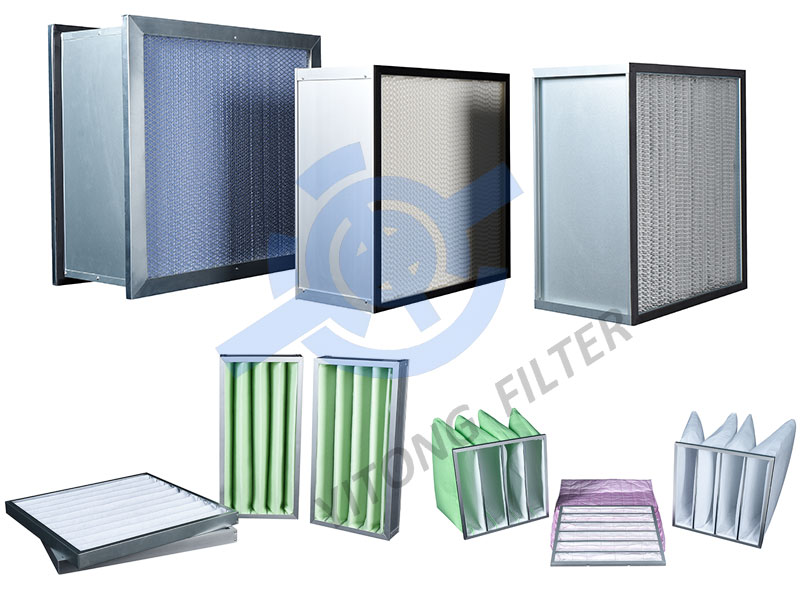 July 04, 2023
July 04, 2023
In cleanrooms and dust-free rooms, Primary, Medium, and HEPA Filters play a crucial role in purifying the air and removing harmful substances such as particles and microorganisms. However, many people may be confused about the standards for Primary, Medium, and HEPA Filters. This article will introduce the standards for Primary, Medium, and HEPA Filters and how to choose the appropriate air filter based on different environmental needs.

Standards for Primary, Medium, and HEPA Filters
Primary, Medium, and HEPA Filters are usually distinguished based on their filter grades. Filter grades are determined based on their filtration efficiency and particle capture capabilities. Common grades for Primary, Medium, and HEPA Filters are: G1-G4 for pre filters, F5-F9 for medium-efficiency filters, and H10-H14 for high-efficiency filters. These grades can be evaluated according to the European EN779 standard or the American ASHRAE 52.2 standard.
The standards for Primary, Medium, and HEPA Filters primarily include the following aspects:
1. Capture Efficiency: The core function of Primary, Medium, and HEPA Filters is to capture and remove harmful substances such as particles and microorganisms from the air. Therefore, the capture efficiency of the filter is an important indicator for evaluating its performance. Generally, pre air filters have a capture efficiency of 40%-80%, medium-efficiency filters have a capture efficiency of 60%-95%, and HEPA filters can achieve a capture efficiency of up to 99.97%.
2. Pressure Loss: Pressure loss refers to the resistance encountered by airflow when passing through the filter. Higher pressure loss can lead to increased energy consumption and increased workload for fans. Therefore, when choosing Primary, Medium, and HEPA Filters, it is necessary to consider their pressure loss and minimize it while meeting the capture efficiency requirements.
3. Lifespan: The lifespan of Primary, Medium, and HEPA Filters is also an important factor in determining their cost-effectiveness. The lifespan is usually determined by factors such as filtration efficiency, pressure loss, and cleaning or replacement cycles. In general, the lifespan of pre air filters is 1-2 years, medium-efficiency filters last 6 months to 1 year, and HEPA filters last 3-6 months.
4. Applicable Environment: The selection of Primary, Medium, and HEPA Filters also depends on the environmental requirements. Different environments have different air quality requirements, so it is necessary to choose air filters that are suitable for specific environmental needs. For example, in places such as hospital operating rooms and laboratories that require extremely high air quality, high-efficiency air filters are usually chosen.
Choosing the Appropriate Filter for Different Environmental Needs
Choosing the appropriate Primary, Medium, and HEPA Filters is crucial based on different environmental needs. Here are some examples of scenarios and corresponding recommendations for Primary, Medium, and HEPA Filters:
1. Home Air Purification: For regular household use, a combination of pre-air filters and medium-efficiency air filters is usually sufficient to meet the needs. Pre-air filters can remove larger particles such as dust and pet dander from indoor air, while medium-efficiency filters can further remove smaller particles such as pollen and bacteria.
2. Hospital Operating Rooms: Hospital operating rooms have particularly high requirements for air quality and require high-efficiency filters to remove tiny particles and microorganisms. In such cases, it is recommended to choose high-efficiency filters with a grade of H14.
3. Precision Electronics Manufacturing: The precision electronics manufacturing industry, which requires clean air, usually requires high-efficiency filters to prevent the impact of tiny particles on product quality. Choosing a medium-efficiency filter with a grade of F9 or a high-efficiency filter with a grade of H10 is a common choice in this case.
4. HVAC Systems: In large HVAC systems found in commercial buildings or offices, it is usually necessary to select a combination of pre-air filters and medium-efficiency filters to ensure the normal operation of the HVAC system and provide good indoor air quality.
The standards for Primary, Medium, and HEPA Filters mainly include capture efficiency, pressure loss, lifespan, and applicable environment. Choosing the appropriate air filter based on different environmental needs is particularly important, as it ensures air quality while reducing energy consumption and maintenance costs. When selecting filters, it is important to make decisions based on actual needs and professional advice.